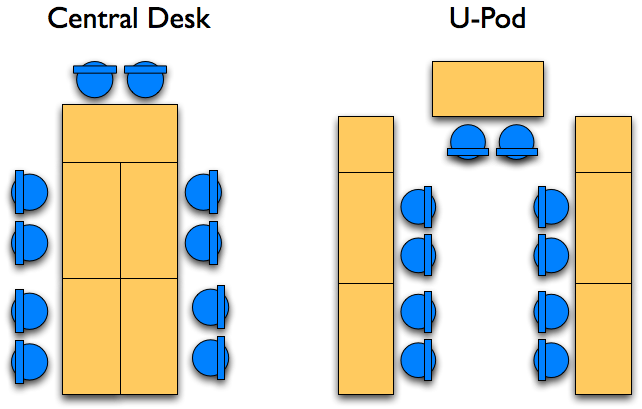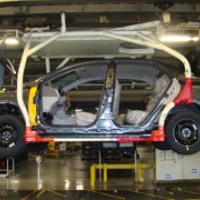Caves and Common
That's the typical agile team room (blogged by Martin Fowler).
This is sometimes also called a War Room.
Another blog that argues for this setup with lots of references: The Ultimate Software Development Office Layout
Inward facing U-Shape
Another setup. Well, it probably goes with an open space for multiple teams. Cool idea of joining a whiteboard and special projector. Each team member can share their screens on the team board with a single button press.
U-Pod
 Martin Fowler blogged about another option of a U shaped space, where people face out side. While it is easier to roll over towards each other, it is harder to find a place for a team board. And avoid the corners, bad for pairing.
Martin Fowler blogged about another option of a U shaped space, where people face out side. While it is easier to roll over towards each other, it is harder to find a place for a team board. And avoid the corners, bad for pairing.
Here's a recommendation by someone who tried it.
This is sometimes referred to as "The Bullpen".
 Half Height Cubicles
Half Height Cubicles
Richard Cheng recommends half height cubicles. His slides show some additional options, considerations and aspects (I think he's missing the point of avoiding the corner made by Martin Fowler). In context of his slideshare, I think this is evangelized as an improvement to the previous single person cubicles.
 The Bionic Office
The Bionic Office
Right... Cool, perfect for focus and personal effectiveness, but totally optimized for working alone, inhibiting communication and collaboration.
After the first wow effect, agile teams optimize for team results rather than individual performance.
Overviews
Dafydd Rees (the programmer) shares his experience with different arrangements covering more or less similar setups.
InfoQ cites Mike Cohn on Workspaces for Effective Agility - not so much about the physical layout, but some aspects to take care of.
My Conclusion
There are many variants, and some would be more effective than others depending on context, individuals, team size, company culture and office constraints. You'd want to consider:
- Ease of communication
- Ability to focus (reduce distractions)
- Team ownership of the space (use of information radiators)
- Adaptability when needs change
What's your experience with various office setups?
Update:
A short clip case studying the Stanford design school, and their concept of the impact of the work environment on learning, engagement and teamwork.
A short clip case studying the Stanford design school, and their concept of the impact of the work environment on learning, engagement and teamwork.


